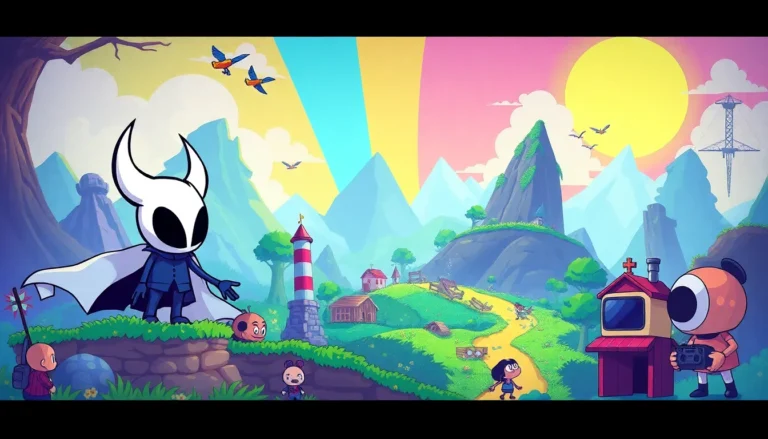Indie games are like the quirky cousins of the gaming world—full of personality and often surprising in the best ways. They’re created by small teams or even solo developers who pour their hearts and souls into crafting unique experiences. Forget the big-budget blockbusters; indie games thrive on creativity and innovation, often delivering stories and gameplay that challenge the status quo.
Indie Games Meaning
Indie games represent a significant part of the gaming landscape. They emerge from small development teams or individual creators who prioritize creativity over commercial viability. These games often challenge traditional gaming norms and foster innovative gameplay experiences.
Focusing on artistic expression, indie games frequently tell unique stories that resonate with players. Developers usually explore diverse themes, pushing boundaries often overlooked by larger studios. Players often find that indie games offer more personal experiences, reflecting the visions of their creators.
Many indie games utilize unconventional art styles and mechanics, differentiating themselves from mainstream titles. The simplicity of design can lead to an engaging player experience, emphasizing storytelling or exploration. Popular titles such as “Celeste” and “Hollow Knight” exemplify the strength of indie games in delivering high-quality gameplay.
A flourishing community surrounds indie games, promoting collaboration among developers and fans. Events like indie game expos and online forums allow creators to share ideas and receive feedback. This sense of community amplifies creativity and inspires new projects.
Revenue models for indie games vary significantly, often relying on digital distribution platforms. Platforms such as Steam and itch.io enable developers to reach a global audience without substantial marketing budgets. Successful games can achieve commercial success despite limited resources.
Overall, the indie game movement highlights a shift in the industry towards creative exploration and diversity. Gamers increasingly turn to these titles for fresh narratives and innovative mechanics, valuing the artistry behind each game.
Characteristics of Indie Games

Indie games stand out in the gaming world for their defining traits. These games emphasize unique development approaches and creative processes.
Low Budgets and Independent Development
Low budgets characterize indie games, often resulting from small teams or solo developers. Spending constraints inspire innovative solutions that bring new ideas to life. Several notable titles emerge from this independent development, showcasing talent without the backing of major publishers. Access to digital platforms allows developers to distribute their work widely. Many indie games rely on crowdfunding, which connects them directly to their audience. This model supports creative individuals who focus on gameplay quality rather than high production costs.
Creative Freedom and Innovation
Creative freedom fosters innovative gameplay in indie games. Developers often explore unconventional themes and narratives, providing fresh experiences that players crave. Experimental mechanics invite players to engage in unexpected ways, breaking traditional molds. Unique art styles enhance the overall storytelling, setting indie games apart visually. Freedom from commercial pressures encourages risk-taking, allowing developers to innovate. Titles like “Celeste” and “Hollow Knight” exemplify how this creative liberty leads to memorable gameplay experiences.
Popular Indie Games
Indie games often create captivating experiences that attract a diverse audience. Many standout titles have left a significant mark on gaming.
Notable Titles in the Genre
“Celeste” captivates players with its challenging platforming and heartfelt narrative. “Hollow Knight” enchants with its intricately designed world and fluid combat system. “Undertale” innovates through unique storytelling and player choice. “Stardew Valley” offers a relaxing farming simulator that encourages creativity. “Cuphead” stands out for its distinct art style and punishing difficulty.
Impact on the Gaming Industry
Indie games challenge traditional gaming norms. They encourage mainstream developers to experiment with unconventional mechanics. Many successful indie titles demonstrate that quality doesn’t rely solely on large budgets. Increased visibility on digital platforms allows smaller developers to reach wider audiences. Movements towards crowdfunding have empowered creators, enhancing game diversity. Players now seek out indie games for their unique narratives and artistic styles, increasing overall demand for innovative gaming experiences.
The Evolution of Indie Games
Indie games have undergone significant evolution, reflecting changes in technology and player preferences. They originated from the desire of small teams to create unique gaming experiences outside major industry constraints.
Historical Context
The history of indie games dates back to the early days of gaming when enthusiasts developed games for personal enjoyment. In the 1980s, platforms like MS-DOS allowed developers to distribute their games independently. The rise of digital distribution in the 2000s marked a turning point. Services such as Steam provided visibility and accessibility to a broader audience, reducing reliance on traditional publishers. The success of titles like “Braid” and “I Am Alive” in the late 2000s showcased the potential of indie games to compete in a mainstream market.
Growing Popularity and Recognition
Indie games gained popularity as players sought alternatives to high-budget titles. Accessibility improved with increases in digital platforms and streaming services, creating opportunities for developers to reach new audiences. Recognition grew as festivals such as IndieCade and the IGF highlighted indie titles. Critical acclaim often followed, evident from awards won by games like “Super Meat Boy” and “Celeste.” These accolades helped raise awareness and appreciation for indie creations. Gamers passionately supported notable titles through word-of-mouth, driving interest and sales. Over time, indie games have cemented their place as a vital component of the gaming industry, advocating for creativity and unique storytelling.





